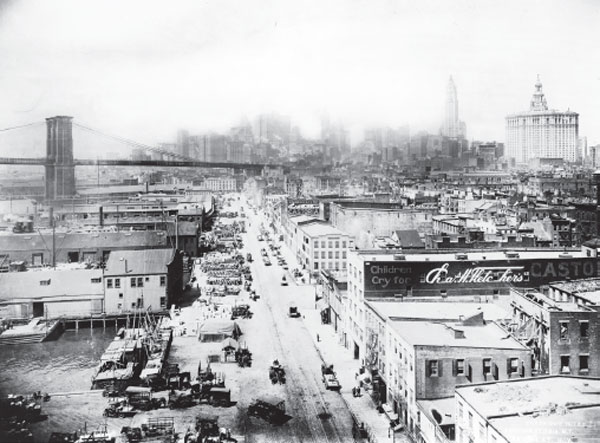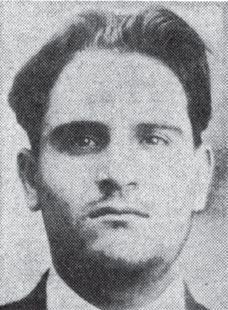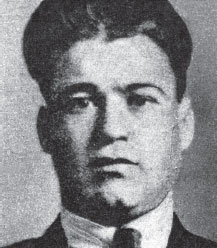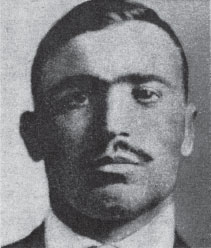
Gangsters Lorenzo Biondo and Anthony Manfriedo hid out in Brooklyn, New York, following the Akron shootings. They made the mistake of going out for a night on the town. Courtesy of Library of Congress.
Akron gangsters Lorenzo Biondo and Anthony Manfriedo made an odd couple as they hid from police at a Brooklyn rooming house in New York. Biondo was gruff and grim, a brooding thug who rarely spoke. Manfriedo was pleasant and personable, a naïve lackey who loved to gab. After a few weeks of keeping a low profile, they felt cooped up in the low-rent hideout and needed a break. What would it hurt if they left their claustrophobic confines for a few hours and found a good place to drink?
Biondo and Manfriedo walked to a nearby pool hall—the natural habitat of the Furnace Street gang—and blended in with the crowd in early May 1918. They smoked cigarettes, swigged booze and loosened up. See? Nothing to worry about. They were just two guys enjoying a night out in a city of millions.
A sharp-eyed bartender happened to see a red, puckered wound on Manfriedo’s hand when he ordered a drink. Manfriedo was too busy socializing to notice that the Italian bartender was suddenly watching him suspiciously and listening carefully.
The next day, the telephone rang at the office of Detective Michael Fiaschetti, commander of the acclaimed Italian Squad at the New York Police Department. “He was in my place last night,” the bartender said. “Says he is coming again tonight. Looks like he’d been shot through the hand.”
Fiaschetti had waited weeks for that call. After casting hundreds of lines into the water, the squad finally got a nibble. As the detective recalled years later in a 1929 article in Liberty magazine:
It was the biggest stool pigeon operation I ever had anything to do with. As I’ve explained, it takes all kinds of birds of both sexes to make a stool pigeon system. The Italian Squad had an extensive one, and we pressed the whole of it into service. I got my staff of informers busy, and the detectives under me got theirs. Telephone calls, meetings in obscure places, cajoleries, threats—“You’ll be doing me a big favor, boy,” and “I’ll do something for you,” or “You know I’ve got you right where I want you, and you’d better treat me right.”

Gangsters Lorenzo Biondo and Anthony Manfriedo hid out in Brooklyn, New York, following the Akron shootings. They made the mistake of going out for a night on the town. Courtesy of Library of Congress.
Once again, the stoolies came through. After notifying Detective Harry Welch in Akron, Fiaschetti went incognito to the pool hall that evening and made small talk with patrons. He didn’t have photos of the suspects, though, and didn’t see anything out of the ordinary as he waded through the crowded club of Italian Americans. Only later did he realize that he had chatted with Manfriedo without recognizing him.
Detective Michael Fiaschetti, commander of the Italian Squad at the New York Police Department, helped investigate the Akron police slayings. Author’s collection.
Learning the address of the rooming house through an informant, the detective enlisted officers to stake out the hideout. Two uniformed cops observed the inebriated men returning home around 2:00 a.m. on May 5, ordered them to halt and then overpowered them when they resisted arrest. After a quick frisk, the cops found a concealed pistol on Manfriedo, but Biondo had left his gun in his room.
Welch arrived in New York with two warrants and met up with Fiaschetti, who agreed to accompany Biondo and Manfriedo on the train trip back to Akron. It was a classic “good cop, bad cop” routine as Welch portrayed a two-fisted lawman, while Fiaschetti played up his heritage.
Fiaschetti, age thirty-six, was a native of Morolo, Italy, who immigrated to the United States as a teen in 1886 and joined the New York Police Department at age twenty-two in 1904. Lieutenant Joseph Petrosino, the revered commander of the Italian Squad, recruited Fiaschetti for the elite force and served as his mentor until a vengeful mobster gunned down Petrosino in 1909 during a visit to Italy.
Burly and bullnecked, Fiaschetti had a disarming personality when talking with criminals. He exuded empathy, which made suspects open up to him. Chatting with Manfriedo and Biondo on the train, “I was treating my two prisoners like a couple of dear old pals, laughing and joking and pretending that I took their word for it that the Akron police had pulled a dumb one in having them picked up,” he said.
When Biondo dozed off under Welch’s guard, Fiaschetti took Manfriedo to a different compartment and unleashed a psychological barrage to soften him up. Maybe Biondo wasn’t really his friend, he suggested. Maybe Biondo had ulterior motives for hiding in New York. “Do you know why Biondo has been hanging out with you?” Fiaschetti asked. “I’ll tell you. He was going to kill you.”
Manfriedo angrily denied the suggestion, but as the train hurtled along the tracks, he started to lose his confidence. After all, he was only a lookout and Biondo was a killer. The gang had shot him once before—a bullet through the hand—over a smaller matter. Maybe he knew too much.

Anthony Manfriedo served as a lookout during the slayings of Patrolmen Ed Costigan and Joe Hunt. Courtesy of Akron Police Museum.
If Manfriedo had any knowledge of the Akron police killings, he should confess to avoid the electric chair, Fiaschetti badgered. “Come through, Manfriedo, and you won’t burn,” the detective said. “Do the right thing, and you’ll get off with a prison sentence.”
After a moment of silence, Manfriedo caved. “It was Rosario Borgia,” he said. “It all began with him.”
A murmur swept the Summit County Jail on Monday as word spread about the arrival of two new prisoners. Manfriedo and Biondo took turns in the interrogation room, but instead of undergoing the third degree, they faced Fiaschetti’s gentle coaxing. The New York detective translated Manfriedo’s confession about the slayings of Patrolmen Ed Costigan and Joe Hunt:
Rosario Borgia told me one week before the crime to kill the policeman Costigan. I told Borgia I was afraid to do it. He said: “Well, you will be the lookout. You will be on the lookout while the other boys do the job.” At 6:30 o’clock on January 10, I met Borgia at the poolroom on Furnace Street and met the boys, Jimmy [Lorenzo Biondo] and this other fellow [Pasquale Biondo]. We were all together at Furnace and Main streets. Then I went over towards the theater for the purpose of being a lookout. While I was on the railroad track on High Street, on guard, I heard the shots fired.
Fiaschetti then went to work on Lorenzo Biondo, telling him the jig was up. If “Jimmy the Bulldog” knew what was good for him, he would admit his role in the slayings, the detective said. During a five-hour session before Fiaschetti and a half dozen other cops, Biondo’s steely façade cracked. The normally taciturn gangster began to weep and confessed, “Borgia gave me a gun and he had another gun in his hand. ‘You kill that policeman,’ he said, pointing to Hunt who was walking up High Street with Patrolman Costigan, ‘Or I will kill you.’”

Lorenzo Biondo gunned down Patrolman Joe Hunt on South High Street in January 1918. Courtesy of Akron Police Museum.
Prosecutor Cletus Roetzel couldn’t help but admire Fiaschetti and his tactics. “He is the cleverest man at securing confessions I have ever known,” Roetzel gushed. “He is never rough, never tries to overawe or frighten the man he is talking to, but gets a confession with much speed. Why, can you believe it, he had James Palmieri crying? Fiaschetti is my idea of a high-class detective. Always the gentleman, he never seems annoyed. But if he is on a case, he won’t rest.”
As Fiaschetti put it, “There’s nothing a cop likes better than catching the killer of a cop. It’s natural; a kind of vendetta feeling.”
Borgia was preparing to go to court when he heard that Biondo and Manfriedo had been captured in Brooklyn. The sensational arrests overshadowed the start of jury selection.
Meanwhile, Patrolman Patsy Pappano, Akron’s answer to the Italian Squad, was following another hot tip. An informant had told him that another Furnace Street gang member, Pasquale “Patsy” Biondo (alias Bolo Mazza), was hiding at a relative’s house in Sandusky, Ohio, a Lake Erie community best known as the home of Cedar Point amusement park.
Welch and Fiaschetti joined Detective Edward J. McDonnell and Sheriff Jim Corey on the drive to Sandusky to hunt for the gangster. The officers left Akron around 5:30 p.m. on Sunday, May 12, but the forty-five-mile drive to Cleveland took more than five hours because their tires kept blowing out on the rough roads. The men caught a train in Cleveland, rode nearly seventy miles and arrived in Sandusky around 2:15 a.m. Monday.
At least they had the element of surprise working for them. The officers managed to find the McDonough Street house in the dark, opened a back door and rushed up the stairs. Pasquale Biondo didn’t know the house was being raided until the officers were in his bedroom.
Fiaschetti awakened the Sicilian and told him to get dressed while McDonnell rummaged through a leather suitcase on the floor. He discovered a .38-caliber handgun wrapped in an old shirt—the revolver that had been used to kill Patrolman Costigan—and quietly gave it to Fiaschetti, who slipped it into his pocket. The gangster hadn’t even bothered to get rid of the evidence.

Pasquale Biondo was paid $100 to kill Patrolman Ed Costigan in 1918. He was captured at a hideout in Sandusky. Courtesy of Akron Police Museum.
Biondo insisted his name was Bolo Mazza, but Fiaschetti tripped him up.
“Whose bag is that over there?” he asked.
“Mine,” the suspect replied.
The detective had to chuckle because the name “Pasquale Biondo” was stamped on the suitcase. The officers arrested the gangster and took him by train and automobile to Summit County Jail, where another murmur arose among prisoners. The Furnace Street gang occupied at least six cells.
With Fiaschetti serving as interpreter, Pasquale Biondo dictated a twenty-three-page confession to court stenographer Albert Walker about the slaying of Ed Costigan. In it, Biondo claimed, “Rosario told me I would be paid $150 for killing ‘Red.’ This was the same night, a half-hour before the murder.…‘You gotta do this work or I kill you.’…Sometimes he pointed a gun at me and told me that if I do not kill this Red Policeman, he kill me.…And to save my own life, I killed him.”
A grand jury indicted Anthony Manfriedo, Lorenzo Biondo and Pasquale Biondo in the murders of Costigan and Hunt. When arraigned before Judge Ervin D. Fritch, all three pleaded not guilty, although Pasquale technically blurted out, “Not guilty! I was forced to do it.”
Arguing among themselves, the hoodlums returned to jail while the Summit County justice system turned its full attention to the murder trial of Rosario Borgia. “I’m going to pull something big in this case and I’m not going to take any chances by talking,” Prosecutor Roetzel told an Akron reporter. “When the time comes, I believe my judgment in this respect will be found to be correct.”